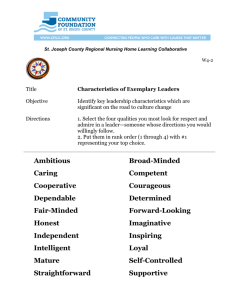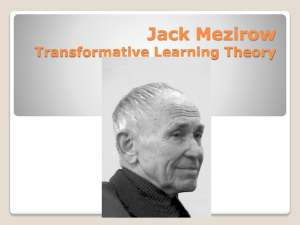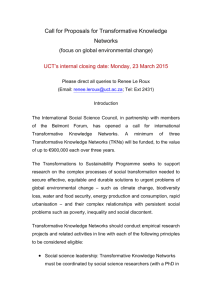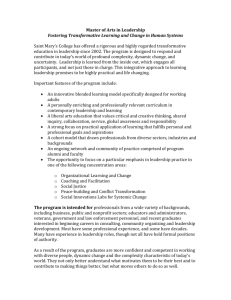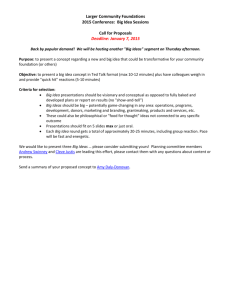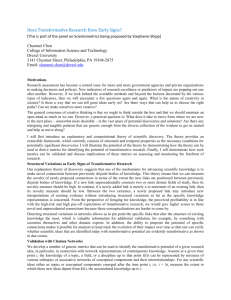TRANSFORMATIVE LEADERSHIP 101
advertisement
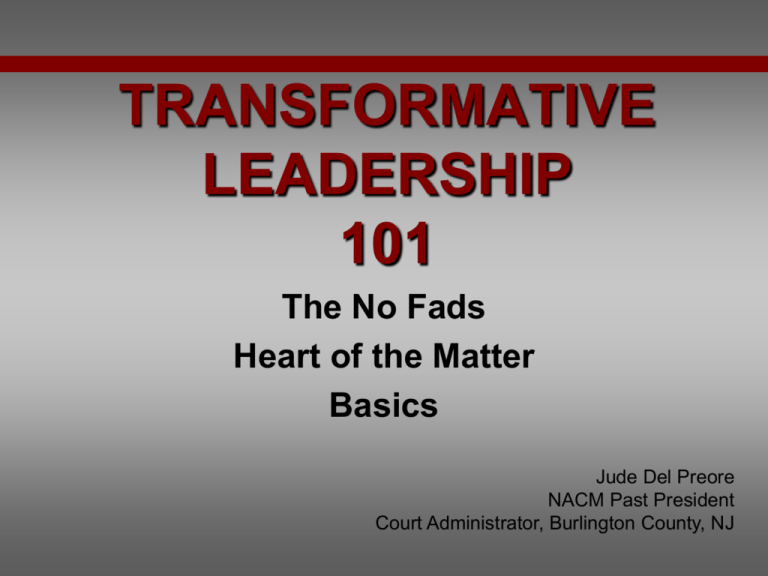
TRANSFORMATIVE LEADERSHIP 101 The No Fads Heart of the Matter Basics Jude Del Preore NACM Past President Court Administrator, Burlington County, NJ LEADERSHIP “When leadership is defined not as a position you hold but as a way of being, you discover that you can lead from wherever you are.” OBJECTIVES Identify the characteristics and basics of Transformative Leadership Understand the Leadership Challenge Explore the importance of trust to Transformative Leadership Learn the basics of Encouraging the Heart EXERCISE WHO INSPIRES YOU? Think about a person (alive or deceased) that you consider a leader. Describe the traits that you believe the leader has, and why you would be willing to follow this person’s leadership. LEADER ROLE MODELS Age: 18-30 Over 30 Family Members 40% 46% Teacher or Coach 26% 14% Community Leader 11% 8% Business Leader 7% 23% Political Leader 4% 4% Professional Athlete 3% 0% Entertainer 2% 0% None/Other/Not Sure 7% 4% The leaders who have the most influence are the leaders who are closest to us. Everything that you will ever do as a leader is based on one major assumption. YOU can make a difference. What do you look for and admire in a leader, someone whose direction you would willingly follow? EXERCISE ___ Ambitious ___ Broad-Minded ___ Caring ___ Competent ___ Cooperative ___ Courageous ___ Dependable ___ Determined ___ Fair-Minded ___ Forward-Looking ___ Honest ___ Imaginative ___ Independent ___ Inspiring ___ Intelligent ___ Loyal ___ Mature ___ Self-Controlled ___ Straightforward ___ Supportive TOTAL SAMPLE 26% Ambitious 40% Broad-Minded 20% Caring 64% Competent 26% Cooperative 21% Courageous 37% Dependable 28% Determined 35% Fair-Minded 70% Forward-Looking 85% Honest 18% Imaginative 6% Independent 69% Inspiring 42% Intelligent 18% Loyal 16% Mature 11% Self-Controlled 31% Straightforward 36% Supportive Admired Leaders Honest Credibility Trustworthiness Forward-Looking Competent Expertise Inspiring Dynamism 3 Big Ideas 1. Trust is an economic driver, not merely a social virtue. 2. Trust is the #1 leadership competency of the new global economy. 3. Trust is a learnable skill, something we can get good at. EXERCISE How do you cultivate Trust and a Respectful environment? The 13 BEHAVIORS OF HIGH TRUST LEADERS 1. Talk Straight 8. Confront Reality 2. Demonstrate Respect 9. Clarify Expectations 3. Create Transparency 4. Right Wrongs 10. Practice Accountability 11. Listen First 5. Show Loyalty 12. Keep Commitments 6. Deliver Results 13. Extend Trust 7. Get Better REMEMBER… If you don’t believe in the messenger, you won’t believe the message. BASIC LEADERSHIP DEFINITIONS “The ability to translate ideas into reality and sustain them over time.” Warren Bennis Any attempt to influence the behavior of another individual or group. TRANSFORMATIVE LEADERSHIP’S GOAL Transformative leadership’s goal is to “transform” people and organizations in a literal sense – to change them in mind and heart; enlarge vision, insight, and understanding; clarify purposes; make behavior congruent with beliefs, principles, or values; and bring about changes that are permanent, self-perpetuating, and momentum building.” Steven Covey, Author of 7 Habits of Highly Successful People TRANSFORMATIVE LEADERSHIP is a leadership style that creates valuable and positive change in followers. A transformative leader focuses on transforming others to help each other, to look out for each other, to be encouraging and harmonious and to look out for the organization as a whole. In this leadership, the leader enhances the motivation, morale and performance of the follower, group or team. EXERCISE What do you think are the key differences between one who leads and one who manages? LEADERSHIP LADDER • Non Leadership • Transactional Leadership: Goal and Task Oriented • Transformative Leadership: Vision Focused TRANSFORMATIVE LEADERS • Have followers – Not subordinates • Charismatic, transformative, quiet style • Good with people (people-focused) • Give credit to others • Take blame for problems • Understand problems and hurdles are natural • Risk-taking – Open to new ideas • Break the rules to get the job done • Followers work for intrinsic rewards • Be inspired in heart and mind – Show It • Commitment to life-long learning TRANSFORMATIVE LEADERS CONSISTENTLY SHARE 5 CHARACTERISTICS: • Inspire a Shared Vision • Challenge the Process • Enable Others to Act • Model the Way • Encourage the Heart INSPIRE A SHARED VISION Focusing on the future sets leaders apart. “Vision is the lifeblood of any organization. It is what keeps it moving forward. It provides meaning to the day-to-day challenges and setbacks that make up the rumble and tumble of real life.” Michael Hyatt, CEO, Thomas Nelson The difference between a Vision and a Hallucination is the number of people who see it. CHALLENGE THE PROCESS Challenge is the crucible of greatness. “Whatever the case, staring down uncertainty and ultimately overcoming this hurdle was a major theme.” Katherine Winkel, Marketing Communications, Monsanto ENABLE OTHERS TO ACT Leaders Foster Collaboration and Build Trust. LEARN THE POWER OF “WE” People respond more eagerly to the use of “We” v. “I” There is magic in this word! Angie Yim, Hewlett-Packard Create a Climate of Trust Facilitate Relationships MODEL THE WAY Transformative leaders know that if they want to gain commitment and achieve high standards, they must be models of the behavior they expect of others. To effectively model the behavior they expect of others, leaders must be clear about guiding principles. They must clarify values. Find your voice Affirm shared values Remember: Values Drive Commitment ENCOURAGE THE HEART Leadership is not an affair of the head. Leadership is an affair of the heart. Put your in your business and Your business is your ! Lead at a higher level. 7 ESSENTIALS OF ENCOURAGING THE HEART Set Clear Standards Expect the Best Pay Attention Tell the Story Personalize Recognition Celebrate Together Set the Example FINAL EXERCISE 1) Write essential assigned to your group 2) How should this practice be conducted in your organization? 3) Give specific examples of how you can demonstrate this essential practice in your court REMEMBER… Transformative leadership creates valuable and positive change in followers and organizations. Leaders transform followers by Inspiring a Shared Vision Building Trust Encouraging the Heart Activating Higher Order Needs 4 key characteristics of Transformative Leaders Honest Forward-Looking Competent Inspiring Transformative leadership can have significant implications for organizations and staff You have to say yes to making a difference…to integrity…to your beliefs…to big dreams…to collaboration…to trust…to difficult challenges…to setting the example…to learning…and to your heart. Are YOU ready to say “YES” RECOMMENDED READING James M. Kouzes and Barry Z. Posner, The Leadership Challenge, 4th Edition 2007 Ken Blanchard, Leading at a Higher Level, 2007 Stephen Covey, The 8th Habit, 2004 John C. Maxwell, Leadership Gold, 2008

